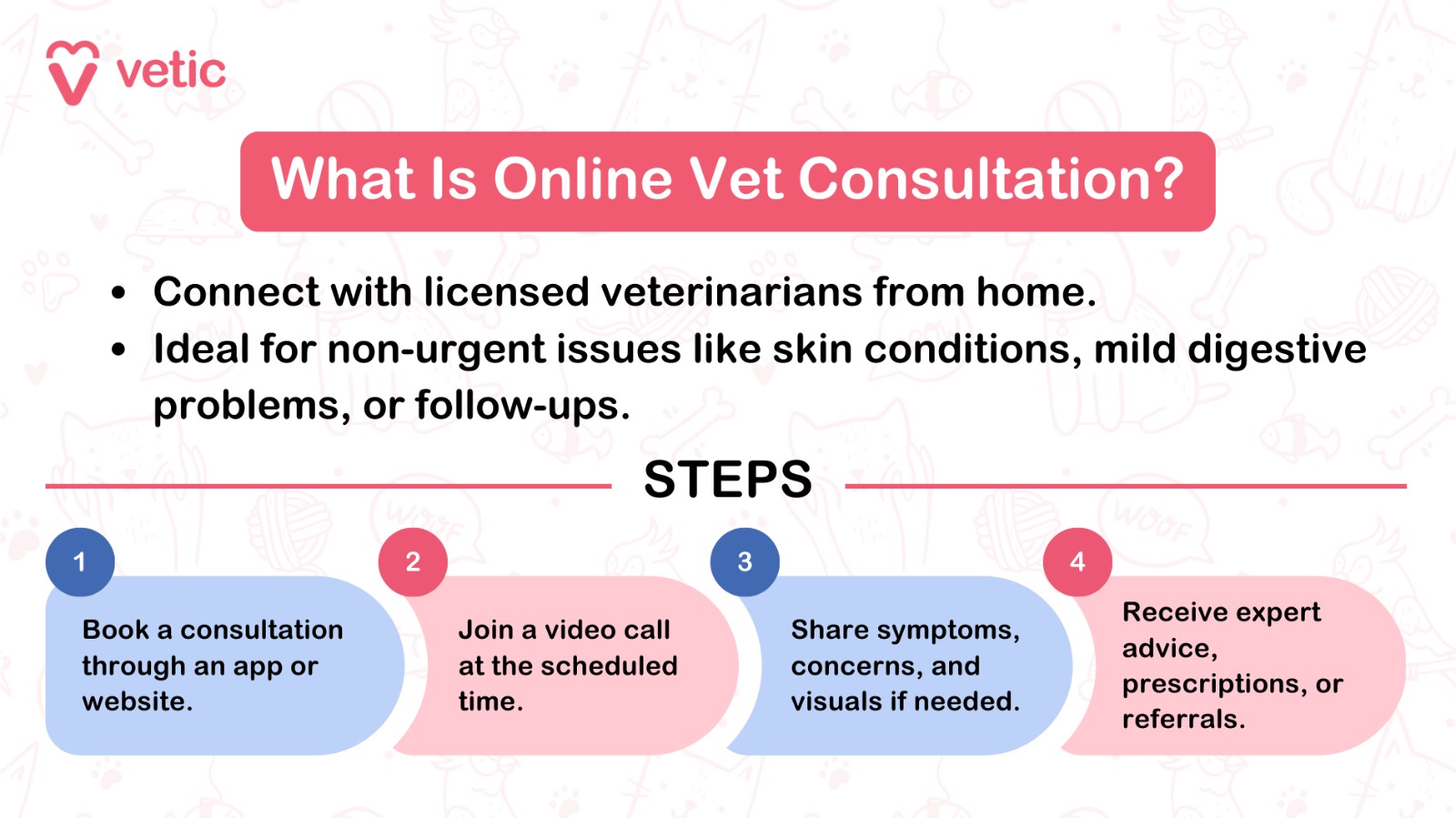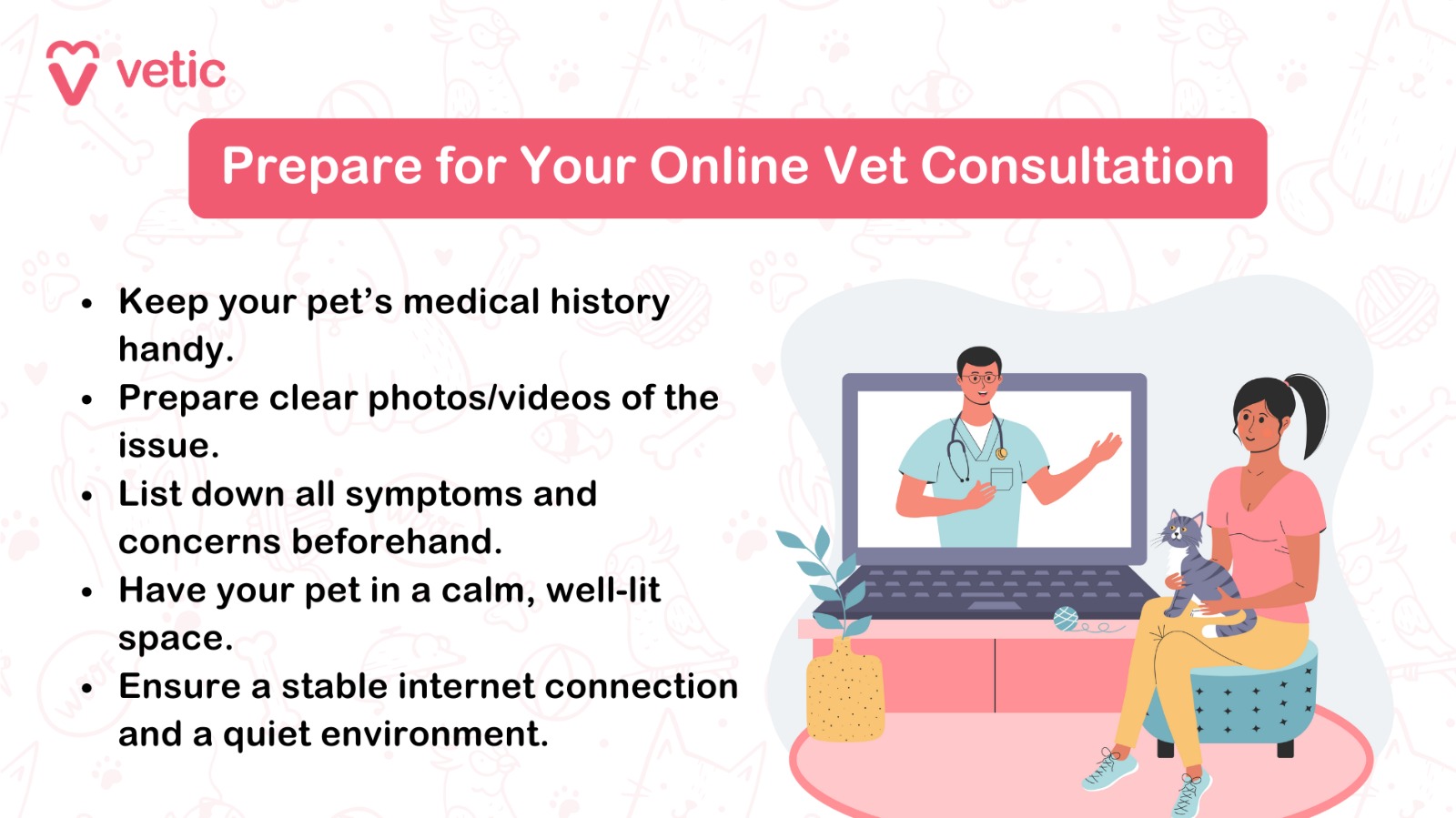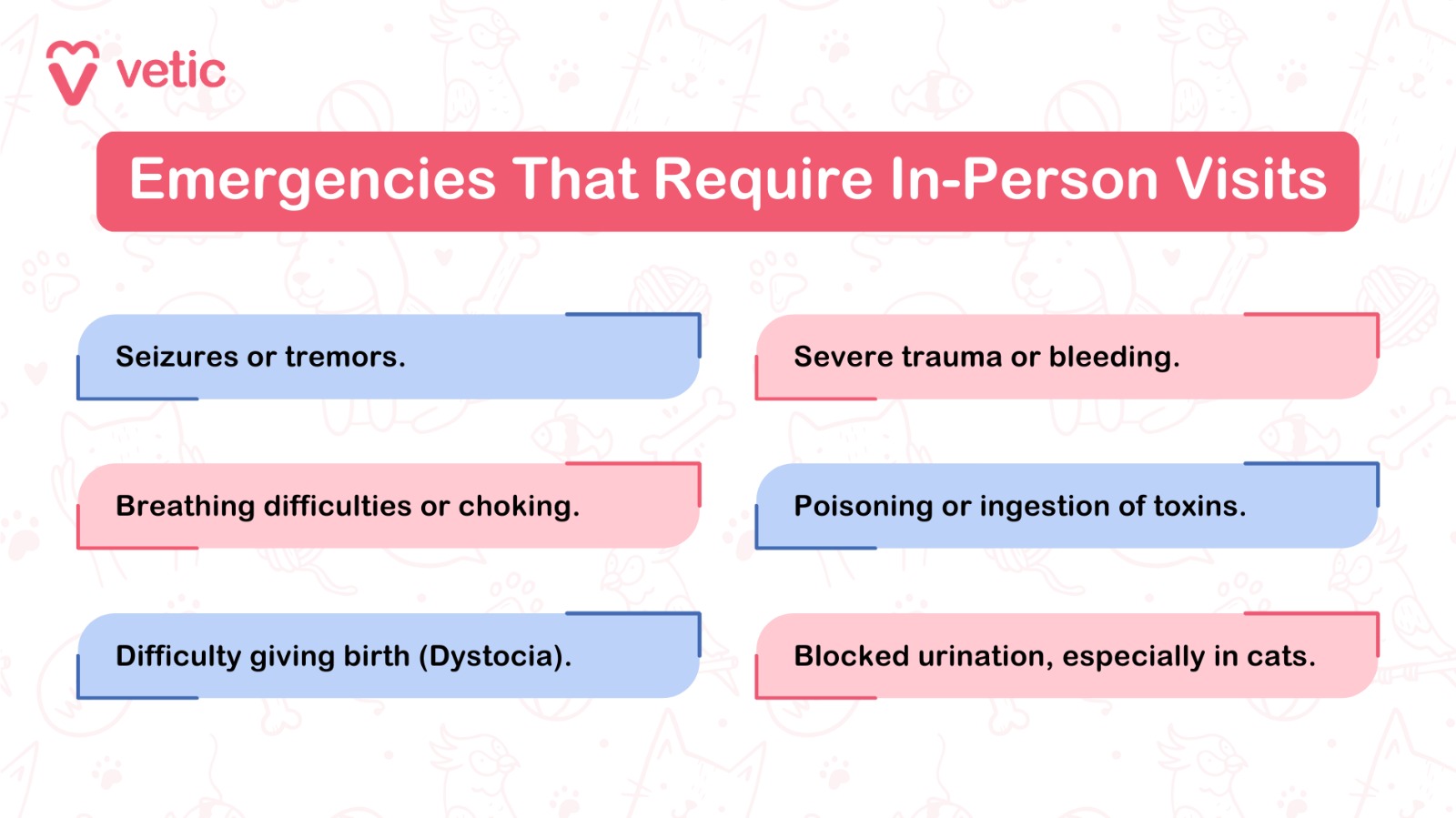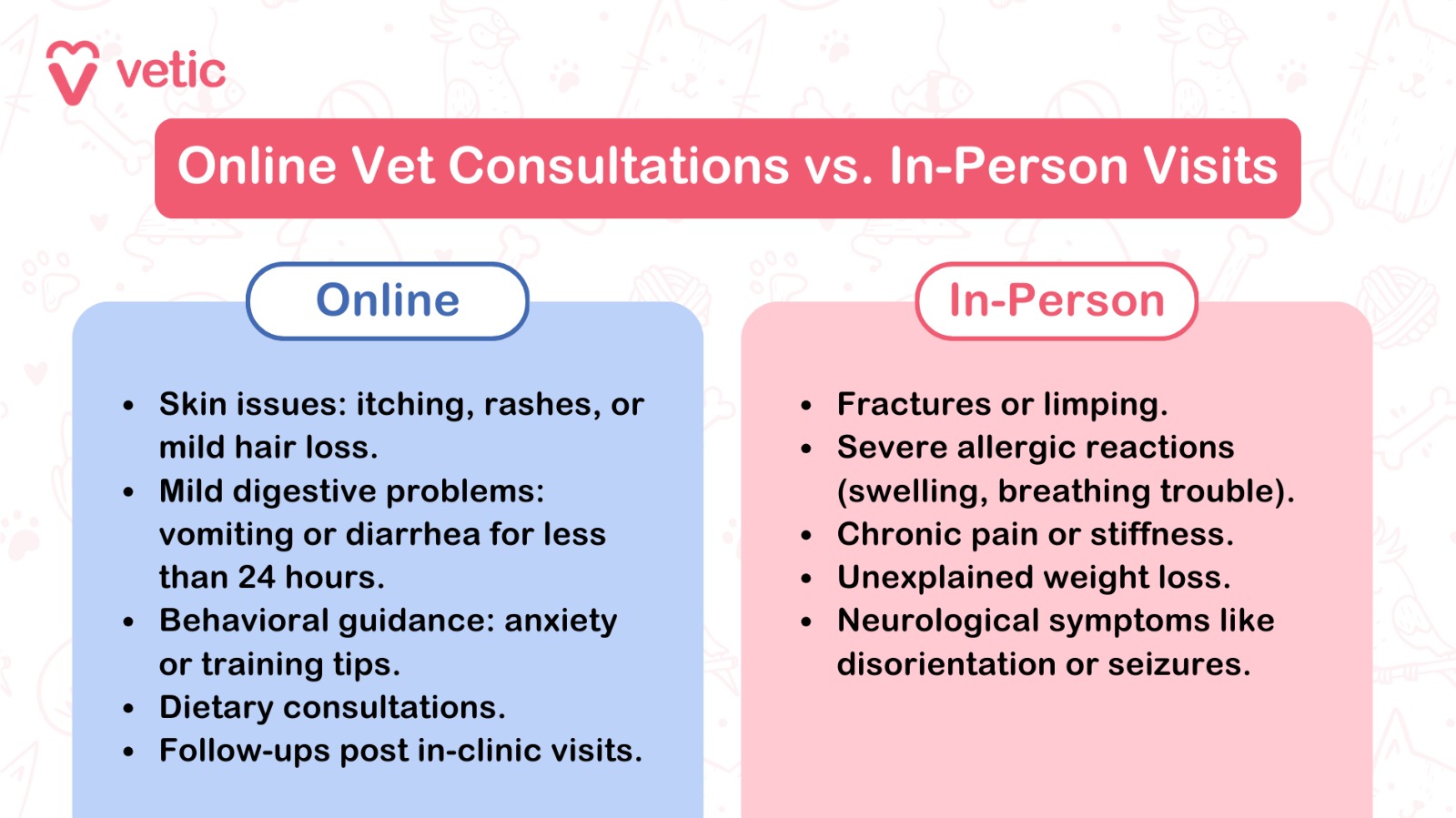Online vet consultations, or teleconsultations, are becoming a popular way for pet parents in India to access veterinary care from the comfort of their homes. With the growing use of technology and a rising awareness of pet healthcare, teleconsultations offer convenience and accessibility.
But what do they involve, and how can you ensure online vet consultations work effectively for your pet’s needs? This article explores the essentials of online vet consultations, from preparation to understanding their limitations, to help you make informed decisions about your pet’s care.
What Are Online Vet Consultations and Telehealth Consultations?

An online vet consultation involves a veterinarian assessing your pet’s health and offering medical advice through digital platforms such as video calls, chats, or apps. Telehealth goes beyond diagnosis and includes services like general advice, monitoring chronic conditions, and dietary consultations.
This approach works particularly well for non-emergency situations, such as minor skin conditions, general behavioral advice, and routine follow-ups. It bridges the gap for pet parents who may not have immediate access to clinics due to distance, time, or unforeseen circumstances.
Globally, telehealth has shown immense growth, with the American Veterinary Medical Association reporting a rise of over 50% in telehealth adoption post-pandemic. In India, pet ownership is booming, with a 2022 survey showing that over 60% of urban pet parents rely on digital solutions for pet care.
What Are the Criteria for a Full and Complete Teleconsultation?
To ensure a meaningful teleconsultation for your pet, several elements are crucial:
- Clear Communication Tools
The platform used for the consultation should have reliable video and audio quality. This ensures the vet can visually assess your pet and hear your concerns clearly. - Comprehensive Medical History
The veterinarian should ask detailed questions about your pet’s age, medical history, lifestyle, and the symptoms you’ve observed. Providing past medical records, vaccination cards, and prescriptions can enhance the quality of the consultation. - Visual Evidence
High-quality photos or videos of your pet’s affected area or unusual behavior can help the vet diagnose issues more effectively. For instance, clear images of a skin rash or videos of limping provide vital clues. - Clear Next Steps
A professional teleconsultation should end with a precise treatment plan, medication prescriptions, or a recommendation for an in-person visit if needed.
How to Choose the Right Veterinary Clinic and Veterinarian for Online Consultation?
When choosing a veterinarian for teleconsultation, prioritize:
- Credentials and Experience
Check if the vet is licensed and experienced in telemedicine. Some clinics specialize in specific areas like dermatology or behavior, which may suit your pet’s needs better. - Reviews and Recommendations
Online reviews and testimonials can provide insights into the quality of service. You can also ask fellow pet parents for recommendations. - Technology and Platform
Ensure the clinic uses secure platforms that are easy to navigate. Apps with features like video calling, document sharing, and post-consultation support are a plus.
What Should You Have Ready Before the Online Vet Consultation?

Preparation is key to a successful teleconsultation. Before your appointment:
- Medical Records
Gather your pet’s previous medical history, vaccination records, and test results. - Detailed Observations
Note changes in your pet’s behavior, appetite, or physical condition. For example, if they’re limping, describe when it started and what might have caused it. - Clear Media Files
Take high-resolution photos or videos of the affected area. For instance, if your pet has an eye infection, ensure the video captures both the swelling and discharge. - Environment Setup
Choose a quiet, well-lit space where your pet feels comfortable. This allows the vet to assess them without distractions.
How to Prepare a List of Concerns for the Vet?
Listing your concerns beforehand ensures you don’t forget important details during the consultation. Include:
- Current Symptoms
Be specific about what you’ve noticed. Instead of saying, “My dog is not eating,” specify, “My dog hasn’t eaten in 24 hours and refuses even their favorite treats.” - Behavioral Changes
Mention unusual actions like excessive licking, hiding, or aggression. - Follow-Up Questions
If the consultation is for a follow-up, ask about progress or next steps.
How to Handle Your Pet During the Teleconsultation?
Handling your pet during a virtual consultation can be challenging, especially if they are anxious or uncooperative. Here are some tips:
- Keep Them Calm
Use their favorite treats or toys to keep them engaged. A relaxed pet is easier to examine. - Position for Visibility
Ensure the vet has a clear view of the area in question. For example, if it’s a skin condition, gently hold your pet so the vet can see the affected area without shadows. - Enlist Help
If needed, have another person assist in holding or calming your pet.
What to Expect During and After the Online Vet Consultation?
A professional teleconsultation should involve:
- Thorough Discussion
The vet will ask detailed questions and may request live demonstrations (e.g., walking your pet to check for limping). - Actionable Advice
Expect clear instructions on diagnostic tests including pet blood tests, medication, dosages, and home care tips. - Post-Consultation Support
Many clinics offer follow-ups via email or chat to address any concerns that arise after the consultation.
Why Can’t All Cases Be Handled Via Online Vet Consultations?

While teleconsultations are helpful in many situations, they cannot replace the hands-on expertise of an in-person veterinary visit for certain emergencies or complex cases. Here are more examples:
Emergencies That Require Prompt In-Person Attention
Signs of emergency in pets may include –
- Seizures: Sudden or recurring seizures require immediate intervention and diagnostics.
- Severe Trauma or Bleeding: Injuries from accidents, fights, or deep wounds need sutures, X-rays, or surgery.
- Difficulty Giving Birth (Dystocia): Prompt assistance is crucial for the survival of the mother and her litter.
- Severe Allergic Reactions: Swelling of the face, difficulty breathing, or sudden collapse are critical emergencies.
- Poisoning or Toxin Ingestion: Many toxins require immediate decontamination or antidotes.
- Blocked Urination: Often seen in male cats, this is a life-threatening emergency needing immediate catheterization.
Acute Conditions Requiring In-Person Evaluation
Acute health conditions refer to sudden pain, injuries, wounds, toxicity and ailments that pose imminent threat to a pet’s overall health.
- Eye Injuries: Corneal scratches or foreign bodies need specialized equipment for examination and treatment.
- Limping or Fractures: X-rays are needed to diagnose the cause accurately.
- Heatstroke: While initial steps can be discussed online, in-clinic care like IV fluids is vital.
- Swelling or Lumps: May need aspiration or biopsy for diagnosis.
When to Opt for Online vs. In-Person Consultation?

Here’s a detailed guide to help you decide:
Conditions Suitable for Online Vet Consultation
- Skin Problems: Rashes, hotspots, itching, or mild hair loss are often manageable with visual assessment and history.
- Minor Digestive Issues: Mild diarrhea, occasional vomiting, or loss of appetite for less than 24 hours.
- Behavioral Advice: Anxiety, aggression, or training tips can be effectively discussed online.
- Routine Dietary Advice: Weight management, nutritional plans, and feeding schedules.
- Follow-Up Consultations: Monitoring recovery or medication effectiveness after an in-person visit.
- Mild Ear Infections: Itching, redness, or odor can often be addressed after visual inspection via video.
Conditions Requiring In-Person Visit
- Breathing Difficulties: Any abnormal breathing pattern needs immediate oxygen therapy and diagnostics.
- Unexplained Weight Loss: May indicate underlying systemic conditions requiring physical exams and lab tests.
- Neurological Symptoms: Tremors, head tilts, or disorientation need advanced diagnostics.
- Chronic Pain or Stiffness: Joint issues or arthritis might require hands-on palpation and imaging.
- Dental Problems: Broken teeth, bleeding gums, or foul breath may require extractions or cleaning under anesthesia.
How to Approach the Decision?
A good rule of thumb is to consider the severity and nature of your pet’s condition. If it seems life-threatening, urgent, or beyond the scope of visual diagnosis, always opt for an in-person visit.
If you’re unsure, start with an online consultation. An experienced vet will guide you on whether an in-person follow-up is necessary.
Conclusion: Balancing Convenience with Care
Online vet consultations are a valuable tool for pet parents, offering quick and expert advice. However, they’re not a replacement for in-person visits, especially for emergencies. By preparing well and understanding their limitations, you can ensure the best outcomes for your pet’s health.
Would you like to explore online consultations with Vetic? Book your first session today and experience expert care at your fingertips!

